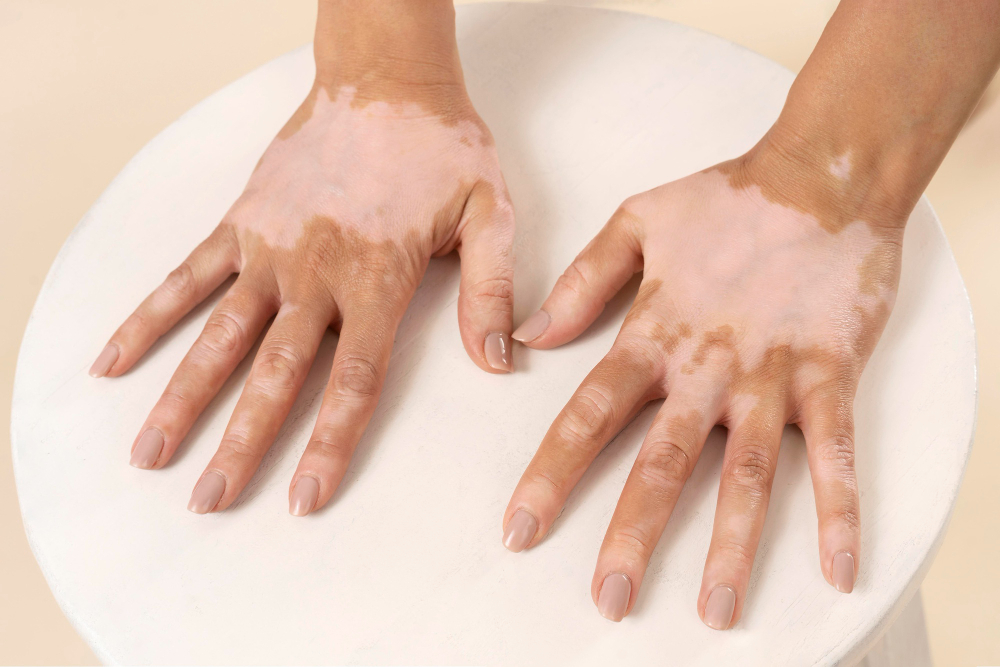Vitiligo, a chronic skin condition characterized by the loss of pigment-producing cells called melanocytes, affects individuals worldwide, irrespective of age, gender, or ethnicity. This condition manifests as depigmented patches on the skin, often causing emotional distress and affecting self-esteem. While conventional treatments like topical corticosteroids, phototherapy, and surgical procedures exist, they have limitations and may not offer satisfactory results for all patients.
Understanding Vitiligo
Vitiligo is a chronic skin disorder characterized by the loss of melanocytes, the pigment-producing cells in the skin, resulting in the development of white patches. These patches can appear on any part of the body, including the face, hands, arms, and feet. While the exact cause of vitiligo is not fully understood, it is believed to be an autoimmune condition, where the body's immune system mistakenly attacks and destroys melanocytes. Other factors such as genetics, environmental triggers, and oxidative stress may also play a role in its development.
Vitiligo can have a significant impact on an individual's physical appearance and emotional well-being. Beyond the visible symptoms, many people with vitiligo may experience feelings of self-consciousness, low self-esteem, and social stigma. Managing vitiligo involves not only addressing the physical symptoms but also supporting the psychological and emotional aspects of the condition.
Limitations of Conventional Treatments
Conventional treatments for vitiligo aim to manage symptoms and promote repigmentation of the skin. These treatments include topical corticosteroids, phototherapy, and surgical procedures such as skin grafting and melanocyte transplantation. While these approaches may be effective for some individuals, they have several limitations.
Topical corticosteroids, for example, can cause skin thinning, stretch marks, and increased susceptibility to infections when used over a long period. Phototherapy, which involves exposing the skin to ultraviolet light, may lead to sunburn, blistering, and an increased risk of skin cancer with prolonged use. Surgical procedures are invasive and carry the risk of scarring and complications.
Furthermore, conventional treatments often provide temporary results and may not address the underlying autoimmune dysfunction that contributes to vitiligo. As a result, many individuals seek alternative or complementary therapies to manage their condition effectively.
The Principles of Homeopathy
A holistic medical approach, homeopathy seeks to enhance the body's natural healing capacities. It is based on the principle of "like cures like," where highly diluted substances that produce symptoms similar to those of the disease are used to treat the individual. Homeopathic remedies are prepared through a process of dilution and succussion, which is believed to enhance their therapeutic effects while minimizing side effects.
In the context of vitiligo, homeopathy takes into account not only the physical symptoms but also the emotional and psychological aspects of the condition. Homeopathic practitioners conduct a thorough evaluation of the individual's symptoms, medical history, and overall constitution to determine the most appropriate remedy for their unique needs.
Home Remedies for Vitiligo
In addition to conventional treatments and homeopathy, several home remedies may help manage vitiligo symptoms and support overall skin health:
1. Turmeric Paste
Turmeric, a spice commonly used in cooking, contains curcumin, a compound with potent anti-inflammatory and antioxidant properties. Applying a paste made from turmeric powder and water to vitiligo-affected areas may help reduce inflammation and promote healing.
2. Ginger Extract
Ginger is another natural ingredient known for its anti-inflammatory and antioxidant effects. Applying freshly extracted ginger juice to vitiligo patches can help improve blood circulation and stimulate melanocyte activity, potentially promoting repigmentation.
3. Ginkgo Biloba
Ginkgo biloba extract has been studied for its potential therapeutic effects on vitiligo. This herbal supplement is believed to have antioxidant properties that may help protect melanocytes from oxidative stress and support skin health. Consuming ginkgo biloba supplements or applying ginkgo biloba extract topically may aid in repigmentation.
4. Copper-Rich Foods
Copper is an essential mineral required for melanin production, the pigment responsible for skin color. Including copper-rich foods such as nuts, seeds, whole grains, and seafood in the diet may help support melanocyte function and promote pigmentation in vitiligo-affected areas.
5. Sunlight Therapy
Controlled exposure to sunlight, particularly in the early morning or late afternoon, may help stimulate melanocyte activity and promote repigmentation in vitiligo patches. However, it is essential to protect unaffected areas with sunscreen to prevent sunburn and minimize the risk of skin damage.
The Role of Homeopathy in Vitiligo Treatment
Homeopathic treatment for vitiligo focuses on addressing the underlying imbalances within the body and stimulating the body's natural healing mechanisms. Homeopathic remedies are selected based on the individual's specific symptoms, emotional state, and overall constitution, ensuring personalized and effective treatment.
Homeopathy aims to not only treat the physical symptoms of vitiligo but also address the underlying autoimmune dysfunction and restore balance within the body. By taking a holistic approach to healing, homeopathy may help reduce inflammation, promote melanocyte function, and support overall skin health.
Advantages of Homeopathy for Vitiligo
Homeopathy offers several advantages for individuals with vitiligo:
Individualized Treatment: Homeopathy takes into account the unique symptoms and constitution of each individual, ensuring personalized and effective treatment tailored to their specific needs.
Minimal Side Effects: Homeopathic remedies are generally safe and well-tolerated, with minimal risk of adverse reactions or interactions with other medications.
Holistic Approach: By addressing the underlying imbalances within the body, homeopathy aims to promote overall health and well-being in addition to treating vitiligo symptoms.
Conclusion
Vitiligo is a complex skin condition that can have a significant impact on an individual's physical and emotional well-being. While conventional treatments exist, they have limitations and may not offer satisfactory results for all patients. Homeopathy offers a holistic approach to managing vitiligo, focusing on addressing the underlying imbalances within the body and stimulating the body's natural healing mechanisms.
By taking into account the individual's unique symptoms, emotional state, and overall constitution, homeopathy offers personalized and effective treatment options for vitiligo. With its emphasis on promoting overall health and well-being, homeopathy may help reduce inflammation, stimulate melanocyte function, and support repigmentation in vitiligo-affected areas.
Book an Appointment Now: https://www.dharmahomoeo.com
Source: https://diigo.com/0vleqf





Comments